trailer OPEL MOVANO_B 2018 Owner's Manual
[x] Cancel search | Manufacturer: OPEL, Model Year: 2018, Model line: MOVANO_B, Model: OPEL MOVANO_B 2018Pages: 265, PDF Size: 6.39 MB
Page 99 of 265
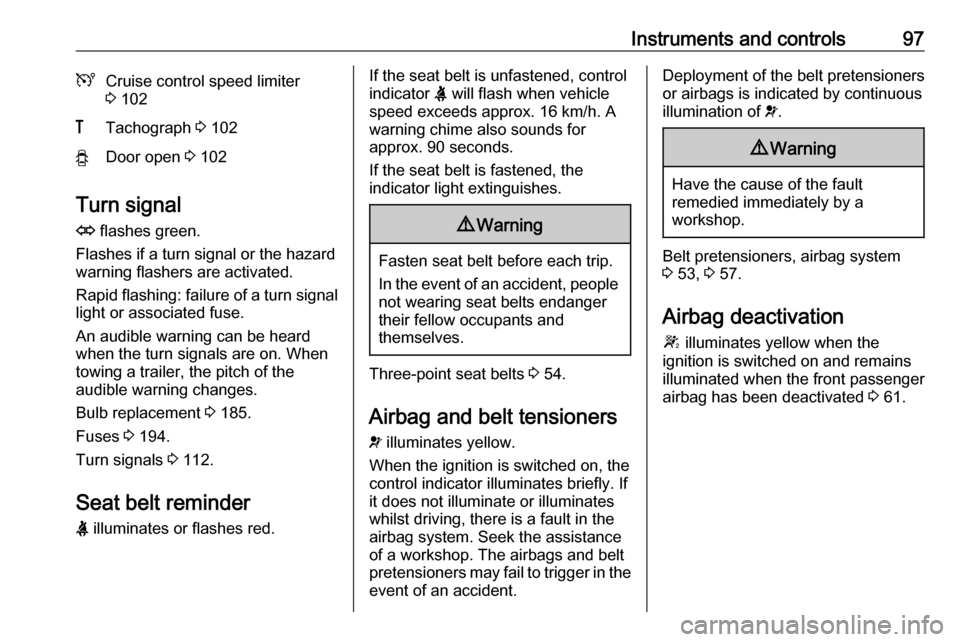
Instruments and controls97UCruise control speed limiter
3 102&Tachograph 3 102yDoor open 3 102
Turn signal
O flashes green.
Flashes if a turn signal or the hazard
warning flashers are activated.
Rapid flashing: failure of a turn signal
light or associated fuse.
An audible warning can be heard
when the turn signals are on. When
towing a trailer, the pitch of the
audible warning changes.
Bulb replacement 3 185.
Fuses 3 194.
Turn signals 3 112.
Seat belt reminder X illuminates or flashes red.
If the seat belt is unfastened, control
indicator X will flash when vehicle
speed exceeds approx. 16 km/h. A warning chime also sounds for
approx. 90 seconds.
If the seat belt is fastened, the
indicator light extinguishes.9 Warning
Fasten seat belt before each trip.
In the event of an accident, people
not wearing seat belts endanger their fellow occupants and
themselves.
Three-point seat belts 3 54.
Airbag and belt tensioners
v illuminates yellow.
When the ignition is switched on, the control indicator illuminates briefly. If
it does not illuminate or illuminates
whilst driving, there is a fault in the
airbag system. Seek the assistance
of a workshop. The airbags and belt
pretensioners may fail to trigger in the event of an accident.
Deployment of the belt pretensioners
or airbags is indicated by continuous
illumination of v.9 Warning
Have the cause of the fault
remedied immediately by a
workshop.
Belt pretensioners, airbag system
3 53, 3 57.
Airbag deactivation
W illuminates yellow when the
ignition is switched on and remains
illuminated when the front passenger
airbag has been deactivated 3 61.
Page 135 of 265

Driving and operating133Driving and
operatingDriving hints ............................... 134
Driving economically ...............134
Control of the vehicle ...............134
Steering ................................... 134
Starting and operating ...............135
New vehicle running-in ............135
Ignition switch positions ...........135
Starting the engine ..................136
Idle speed control ....................137
Overrun cut-off ........................ 137
Stop-start system ....................137
Parking .................................... 140
Air suspension ......................... 141
Engine exhaust .......................... 143
Diesel particle filter ..................143
Catalytic converter ...................143
AdBlue ..................................... 144
Manual transmission ..................151
Manual transmission automa‐ ted .............................................. 151
Transmission display ...............151
Starting the engine ..................152
Selector lever .......................... 152Manual mode........................... 153
Electronic driving programmes 153
Fault ........................................ 154
Interruption of power supply ....155
Brakes ........................................ 155
Antilock brake system .............155
Parking brake .......................... 156
Brake assist ............................. 157
Hill start assist ......................... 157
Ride control systems .................157
Traction Control system ..........157
Electronic stability program .....158
Limited-slip rear axle ...............160
Driver assistance systems .........160
Cruise control .......................... 160
Speed limiter ........................... 164
Parking assist .......................... 164
Rear view camera ...................166
Lane departure warning ..........168
Fuel ............................................ 169
Fuel for diesel engines ............169
Refuelling ................................ 170
Fuel consumption - CO 2-
Emissions ............................... 171
Trailer hitch ................................ 172
General information .................172
Driving characteristics and towing tips .............................. 172
Trailer towing ........................... 172Towing equipment ...................173
Trailer stability assist ...............173
Auxiliary features .......................173
Power take-off ......................... 173
Page 160 of 265
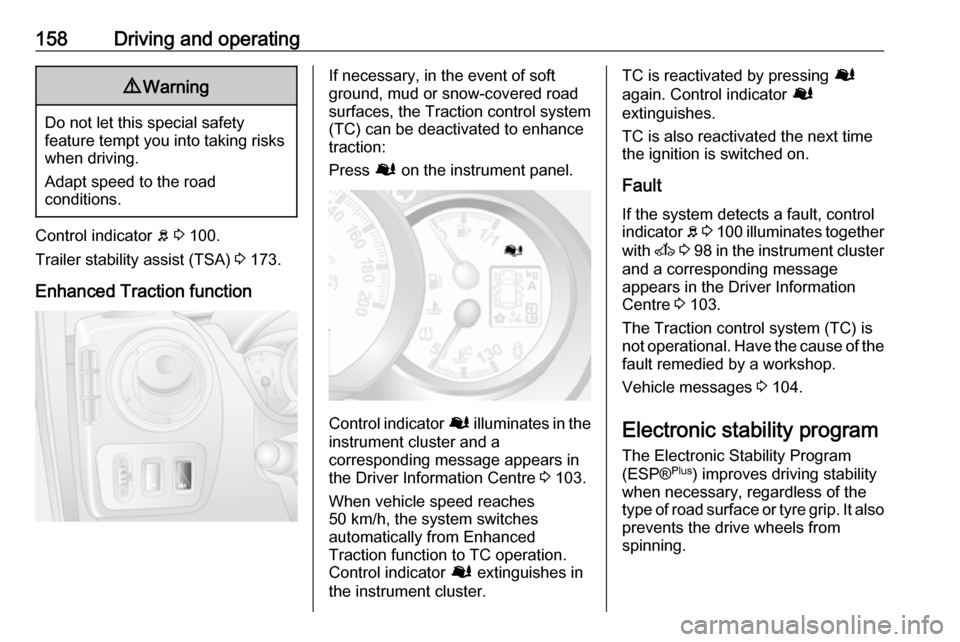
158Driving and operating9Warning
Do not let this special safety
feature tempt you into taking risks
when driving.
Adapt speed to the road
conditions.
Control indicator b 3 100.
Trailer stability assist (TSA) 3 173.
Enhanced Traction function
If necessary, in the event of soft
ground, mud or snow-covered road
surfaces, the Traction control system
(TC) can be deactivated to enhance
traction:
Press Ø on the instrument panel.
Control indicator Ø illuminates in the
instrument cluster and a
corresponding message appears in
the Driver Information Centre 3 103.
When vehicle speed reaches 50 km/h, the system switches
automatically from Enhanced
Traction function to TC operation.
Control indicator Ø extinguishes in
the instrument cluster.
TC is reactivated by pressing Ø
again. Control indicator Ø
extinguishes.
TC is also reactivated the next time
the ignition is switched on.
Fault
If the system detects a fault, control indicator b 3 100 illuminates together
with A 3 98 in the instrument cluster
and a corresponding message
appears in the Driver Information
Centre 3 103.
The Traction control system (TC) is
not operational. Have the cause of the fault remedied by a workshop.
Vehicle messages 3 104.
Electronic stability program
The Electronic Stability Program
(ESP® Plus
) improves driving stability
when necessary, regardless of the type of road surface or tyre grip. It also
prevents the drive wheels from
spinning.
Page 161 of 265
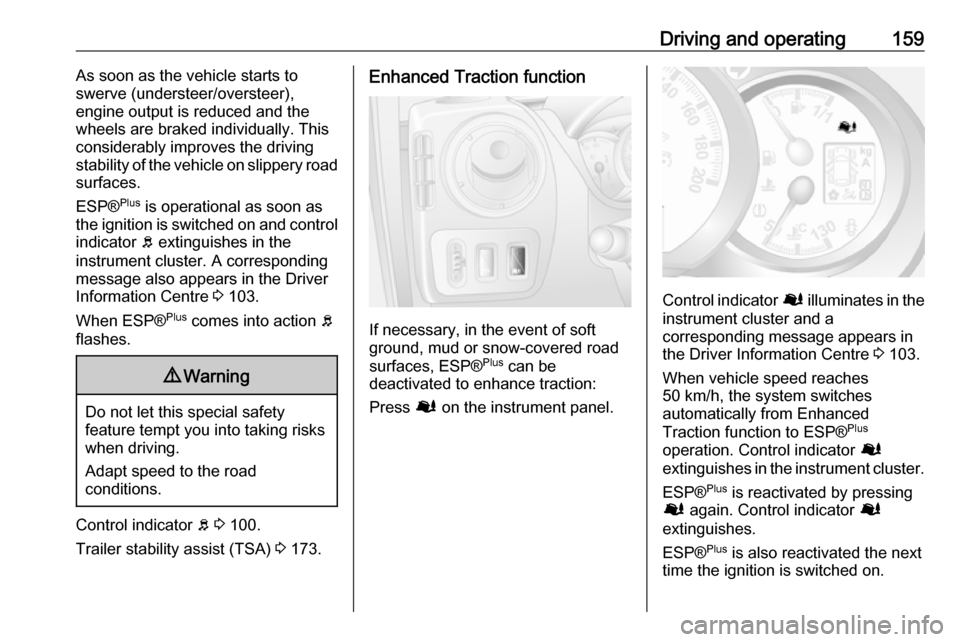
Driving and operating159As soon as the vehicle starts to
swerve (understeer/oversteer),
engine output is reduced and the
wheels are braked individually. This
considerably improves the driving
stability of the vehicle on slippery road
surfaces.
ESP® Plus
is operational as soon as
the ignition is switched on and control
indicator b extinguishes in the
instrument cluster. A corresponding
message also appears in the Driver
Information Centre 3 103.
When ESP® Plus
comes into action b
flashes.9 Warning
Do not let this special safety
feature tempt you into taking risks
when driving.
Adapt speed to the road
conditions.
Control indicator b 3 100.
Trailer stability assist (TSA) 3 173.
Enhanced Traction function
If necessary, in the event of soft
ground, mud or snow-covered road
surfaces, ESP® Plus
can be
deactivated to enhance traction:
Press Ø on the instrument panel.
Control indicator Ø illuminates in the
instrument cluster and a
corresponding message appears in
the Driver Information Centre 3 103.
When vehicle speed reaches
50 km/h, the system switches
automatically from Enhanced
Traction function to ESP® Plus
operation. Control indicator Ø
extinguishes in the instrument cluster.
ESP® Plus
is reactivated by pressing
Ø again. Control indicator Ø
extinguishes.
ESP® Plus
is also reactivated the next
time the ignition is switched on.
Page 174 of 265

172Driving and operatingTrailer hitch
General information
Only use towing equipment that has
been approved for your vehicle.
Entrust fitting of towing equipment at
a later date to a workshop. It may be
necessary to make changes that
affect the cooling system, heat
shields or other equipment.
Driving characteristics and towing tips
In the case of trailers with brakes,
attach the breakaway stopping cable.
Before attaching a trailer, lubricate
the coupling ball. However, do not do so if a stabiliser, which acts on thecoupling ball, is being used to reduce
snaking movements. For trailers with
low driving stability the use of a
stabiliser is recommended.
A maximum speed of 80 km/h must
not be exceeded, even in countries
where higher speeds are permitted.If the trailer starts snaking, drive more slowly, do not attempt to correct the
steering and brake sharply if
necessary.
When driving downhill, drive in the
same gear as if driving uphill and
drive at a similar speed.
Adjust tyre pressure to the value
specified for full load 3 247.
Trailer towing
Trailer loads The permissible trailer loads are
vehicle-dependent and engine-
dependent maximum values which
must not be exceeded. The actual
trailer load is the difference between
the actual gross weight of the trailer
and the actual coupling socket load
with the trailer coupled.
The permissible trailer loads are
specified in the vehicle documents. In
general, they are valid for gradients
up to max. 12%.
The permitted trailer load applies up to the specified incline and up to an
altitude of 1000 metres above sealevel. Since engine power decreases
as altitude increases due to the air
becoming thinner, therefore reducing
climbing ability, the permissible gross
train weight also decreases by 10%
for every 1000 metres of additional
altitude. The gross train weight does
not have to be reduced when driving
on roads with slight inclines (less than 8%, e.g. motorways).
The permissible gross train weight
must not be exceeded. This weight is
specified on the identification plate
3 226.
Vertical coupling load
The vertical coupling load is the load
exerted by the trailer on the coupling
ball. It can be varied by changing the
weight distribution when loading the
trailer.
The maximum permissible vertical
coupling load is specified on the
towing equipment identification plate
and in the vehicle documents. Always aim for the maximum load, especially in the case of heavy trailers. The
vertical coupling load should never
fall below 25 kg.
Page 175 of 265
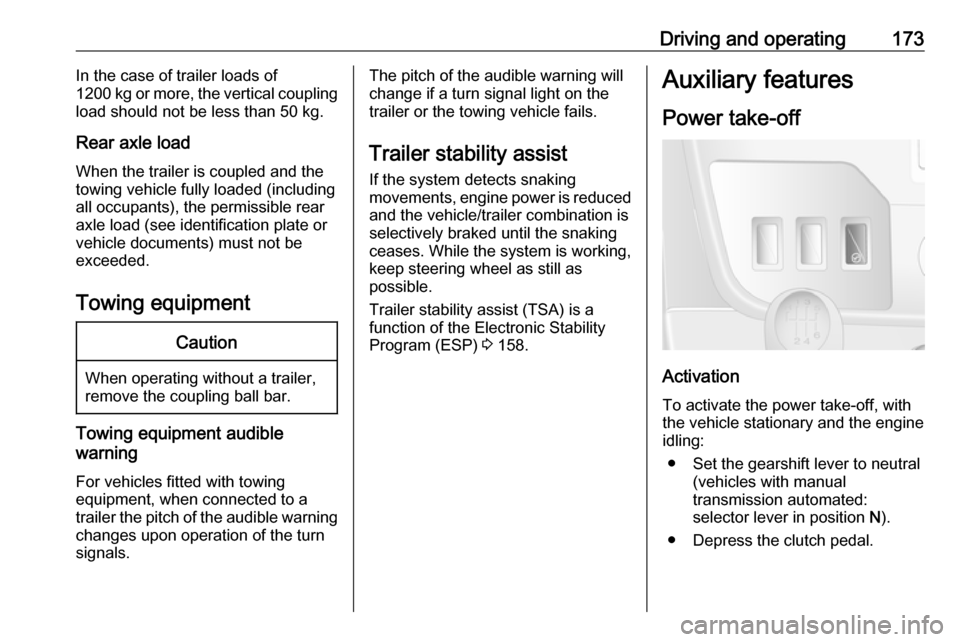
Driving and operating173In the case of trailer loads of
1200 kg or more, the vertical coupling
load should not be less than 50 kg.
Rear axle loadWhen the trailer is coupled and the
towing vehicle fully loaded (including all occupants), the permissible rear
axle load (see identification plate or
vehicle documents) must not be
exceeded.
Towing equipmentCaution
When operating without a trailer,
remove the coupling ball bar.
Towing equipment audible
warning
For vehicles fitted with towing
equipment, when connected to a
trailer the pitch of the audible warning
changes upon operation of the turn
signals.
The pitch of the audible warning will
change if a turn signal light on the
trailer or the towing vehicle fails.
Trailer stability assist
If the system detects snaking
movements, engine power is reduced
and the vehicle/trailer combination is
selectively braked until the snaking ceases. While the system is working,keep steering wheel as still as
possible.
Trailer stability assist (TSA) is a
function of the Electronic Stability
Program (ESP) 3 158.Auxiliary features
Power take-off
Activation
To activate the power take-off, with
the vehicle stationary and the engine
idling:
● Set the gearshift lever to neutral (vehicles with manual
transmission automated:
selector lever in position N).
● Depress the clutch pedal.
Page 204 of 265
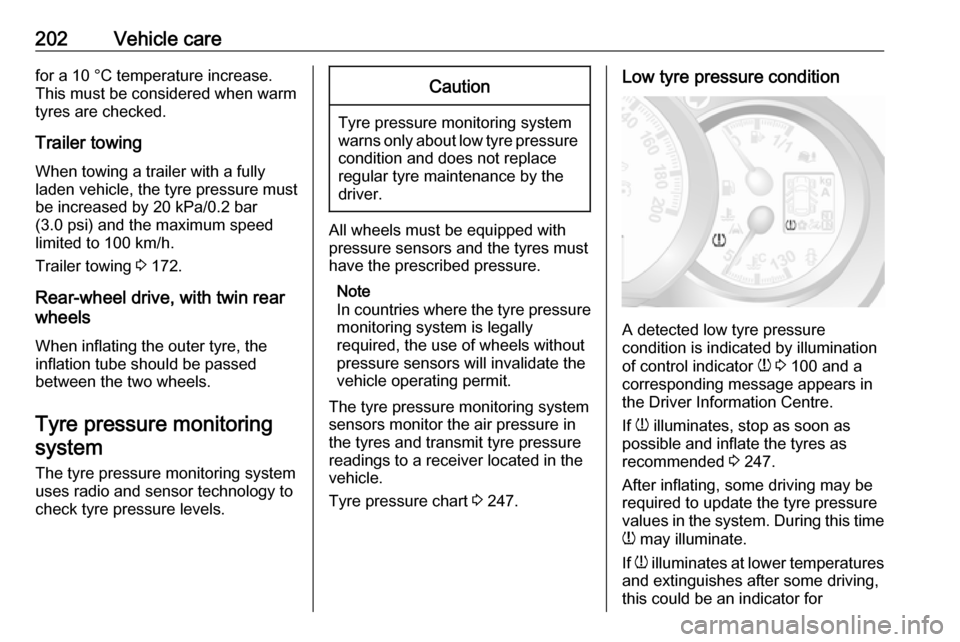
202Vehicle carefor a 10 °C temperature increase.
This must be considered when warm
tyres are checked.
Trailer towing When towing a trailer with a fullyladen vehicle, the tyre pressure must
be increased by 20 kPa/0.2 bar
(3.0 psi) and the maximum speed
limited to 100 km/h.
Trailer towing 3 172.
Rear-wheel drive, with twin rear
wheels
When inflating the outer tyre, the
inflation tube should be passed
between the two wheels.
Tyre pressure monitoringsystem
The tyre pressure monitoring system
uses radio and sensor technology to
check tyre pressure levels.Caution
Tyre pressure monitoring system
warns only about low tyre pressure condition and does not replace
regular tyre maintenance by the
driver.
All wheels must be equipped with pressure sensors and the tyres must
have the prescribed pressure.
Note
In countries where the tyre pressure
monitoring system is legally
required, the use of wheels without
pressure sensors will invalidate the
vehicle operating permit.
The tyre pressure monitoring system
sensors monitor the air pressure in
the tyres and transmit tyre pressure
readings to a receiver located in the
vehicle.
Tyre pressure chart 3 247.
Low tyre pressure condition
A detected low tyre pressure
condition is indicated by illumination
of control indicator w 3 100 and a
corresponding message appears in
the Driver Information Centre.
If w illuminates, stop as soon as
possible and inflate the tyres as
recommended 3 247.
After inflating, some driving may be
required to update the tyre pressure
values in the system. During this time
w may illuminate.
If w illuminates at lower temperatures
and extinguishes after some driving,
this could be an indicator for
Page 225 of 265

Service and maintenance223starting, stop and go operation, trailer
operation, mountain driving, driving
on poor and sandy road surfaces,
increased air pollution, presence of
airborne sand and high dust content,
driving at high altitude and large
variations of temperature. Under
these severe operating conditions,
certain service work may be required more frequently than the regular
service interval.
Service display 3 93.
Confirmations Confirmation of service is recorded inthe Service and warranty booklet.
The date and mileage is completed
with the stamp and signature of the
servicing workshop.
Make sure that the Service and
warranty booklet is completed
correctly as continuous proof of
service is essential if any warranty or goodwill claims are to be met, and is
also a benefit when selling the
vehicle.Service display
The service interval is based on
several parameters depending on
usage.
The service display, located in the
Driver Information Centre, indicates
when the next service is due. Seek
the assistance of a workshop.
Service display 3 93.
Engine oil lever monitor 3 93.Recommended fluids,
lubricants and parts
Recommended fluids andlubricants
Only use products that meet the
recommended specifications.9 Warning
Operating materials are
hazardous and could be
poisonous. Handle with care. Pay
attention to information given on
the containers.
Engine oil
Engine oil is identified by its quality
and its viscosity. Quality is more
important than viscosity when
selecting which engine oil to use. The oil quality ensures e.g. engine
cleanliness, wear protection and oil
aging control, whereas viscosity
grade gives information on the oil's
thickness over a temperature range.
Page 249 of 265
![OPEL MOVANO_B 2018 Owners Manual Technical data247Tyre pressuresFront-wheel driveTyre pressure with full load16)17)EngineGross Vehicle WeightTyreFront
[kPa/bar] (psi)Rear
[kPa/bar] (psi)M9T2800215/65 R16 C 109/107R340/3.4 (49)360/3.6 OPEL MOVANO_B 2018 Owners Manual Technical data247Tyre pressuresFront-wheel driveTyre pressure with full load16)17)EngineGross Vehicle WeightTyreFront
[kPa/bar] (psi)Rear
[kPa/bar] (psi)M9T2800215/65 R16 C 109/107R340/3.4 (49)360/3.6](/img/37/18908/w960_18908-248.png)
Technical data247Tyre pressuresFront-wheel driveTyre pressure with full load16)17)EngineGross Vehicle WeightTyreFront
[kPa/bar] (psi)Rear
[kPa/bar] (psi)M9T2800215/65 R16 C 109/107R340/3.4 (49)360/3.6 (52)3300215/65 R16 C 109/107R360/3.6 (52)430/4.3 (62)3500225/65 R16 C 112/110R380/3.8 (55)460/4.6 (68)3900225/65 R16 C 112/110R380/3.8 (55)460/4.6 (68)16) The spare wheel should be set to the highest applicable pressure shown in the table.
17) When towing a trailer with a fully laden vehicle, the tyre pressure must be increased by 20 kPa/0.2 bar (3.0 psi) and the maximum
speed limited to 100 km/h.Rear-wheel drive, with single rear wheelsTyre pressure with full load 17)EngineGross Vehicle WeightTyreFront
[kPa/bar] (psi)Rear
[kPa/bar] (psi)M9T3500235/65 R16 C 115/113R360/3.6 (52)450/4.5 (65)17) When towing a trailer with a fully laden vehicle, the tyre pressure must be increased by 20 kPa/0.2 bar (3.0 psi) and the maximum
speed limited to 100 km/h.
Page 250 of 265
![OPEL MOVANO_B 2018 Owners Manual 248Technical dataRear-wheel drive, with twin rear wheelsTyre pressure with full load17)EngineGross Vehicle WeightTyreFront
[kPa/bar] (psi)Rear
[kPa/bar] (psi)M9T3500195/75 R16 C 107/105R420/4.2 (61)42 OPEL MOVANO_B 2018 Owners Manual 248Technical dataRear-wheel drive, with twin rear wheelsTyre pressure with full load17)EngineGross Vehicle WeightTyreFront
[kPa/bar] (psi)Rear
[kPa/bar] (psi)M9T3500195/75 R16 C 107/105R420/4.2 (61)42](/img/37/18908/w960_18908-249.png)
248Technical dataRear-wheel drive, with twin rear wheelsTyre pressure with full load17)EngineGross Vehicle WeightTyreFront
[kPa/bar] (psi)Rear
[kPa/bar] (psi)M9T3500195/75 R16 C 107/105R420/4.2 (61)420/4.2 (61)4500195/75 R16 C 107/105R420/4.2 (61)420/4.2 (61)17) When towing a trailer with a fully laden vehicle, the tyre pressure must be increased by 20 kPa/0.2 bar (3.0 psi) and the maximum
speed limited to 100 km/h.
The tyre pressure information label on the driver's door frame indicates the original equipment tyres and the correspondent
tyre pressures. Always inflate tyres to the pressures shown on the label.
Tyre pressure information label 3 201.
Tyre designations 3 200.